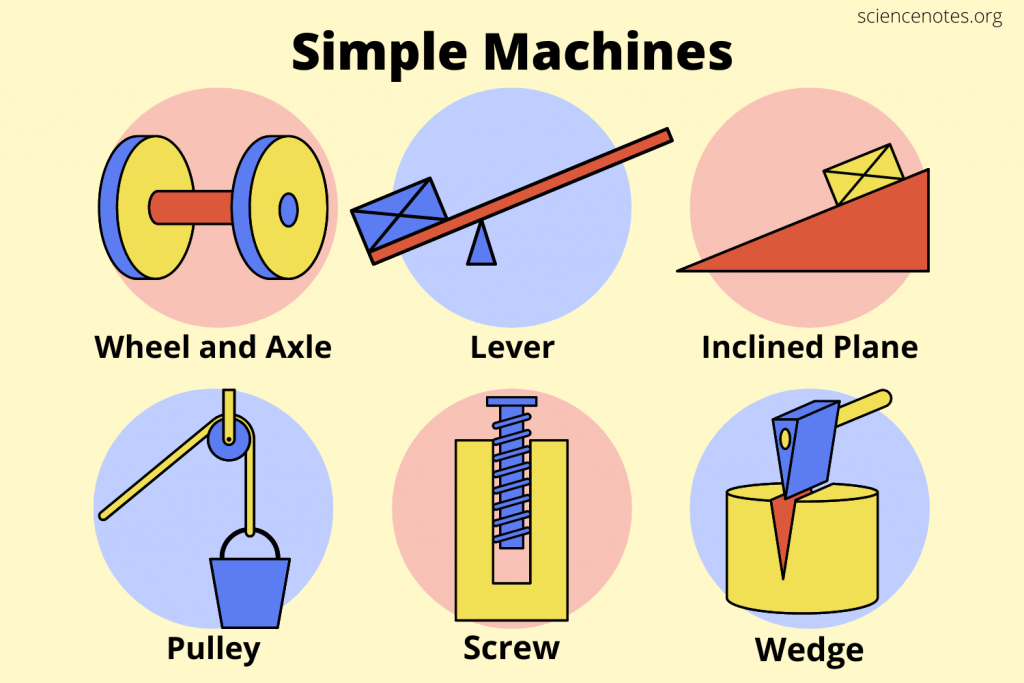Imagine you’re a mighty inventor, just like Leonardo da Vinci! Today, we’re not building flying machines (yet!), but something just as cool: simple machines! These are the building blocks of all sorts of amazing inventions, from the bicycles you ride to the seesaws on the playground. The best part? You can build them yourself using everyday stuff around the house!
This guide will turn your home into a workshop for budding engineers. We’ll explore the fascinating world of simple machines, including levers, wheels and axles, screws, wedges, inclined planes, and pulleys. You’ll learn how these simple machines work and how they’re used in everyday life. But most importantly, we’ll show you how to create incredible projects with them! Get ready for some serious fun and learning!
What Are Simple Machines?
Simple machines are basic mechanical devices that help us perform tasks with less effort. Examples include the lever, wheel and axle, pulley, inclined plane, wedge, and screw. Let’s explore how you can create these simple machines with common household items.

Building Block of Engineering:”6″ Simple Machines:
Simple machines are devices with few or no moving parts that change the direction or strength of a force to make work easier. There are six basic types of simple machines, and they’re all around us! Let’s dive into each one and see some examples:
1.Lever simple machine:

Definition:
A lever is a rigid bar that pivots on a fixed point called a fulcrum. By changing the position of the fulcrum and the effort force (the force you apply), you can lift heavier objects with less effort.
Examples:
Seesaws, crowbars, bottle openers, nutcrackers (a lever you use in the kitchen to crack open tough nuts!), swings.
Fun Fact:
The ancient Egyptians used levers to build massive pyramids!
Simple Machine Activity: Build Your Own Lever:
For this fun activity, you’ll need a ruler, a pencil, and a few objects with different weights. Place the pencil under the ruler near one end to act as a fulcrum. Try lifting the different objects by placing them on either side of the fulcrum. Can you lift heavier objects by placing them closer or further away from the fulcrum? This is the magic of levers!
2.Wheel and Axle simple machine:
Definition:
A wheel and axle is a combination of a wheel attached to a central rod (axle). The wheel rotates around the axle, making it easier to move heavy objects.
Examples:
Bicycles, doorknobs, car wheels, screwdrivers, playground merry-go-rounds.
Fun Fact:
The first wheels were invented in Mesopotamia (present-day Iraq) around 3500 BC!
Simple Machine Project: Design Your Mini Car!
Let’s put the wheel and axle principle into action! Grab some cardboard, bottle caps, straws, and tape. Cut out circles from the cardboard for your wheels and poke holes in the center. Push the straws through the holes and secure them with tape. Now, find a container lid or another small piece of cardboard with a hole in the center to act as your axle. Slide the straw ends of your wheels onto the axle and secure them. Voila! You’ve built a mini car that demonstrates the power of the wheel and axle.
3. Screw in Simple Machine:
Definition:
Screws are like tiny inclined planes wrapped around a cylinder. As you turn the screw, the thread (the inclined plane) gradually moves the object you’re screwing into place, creating a strong and tight connection.
Examples:
Screwdrivers, jar lids, playground slides (the slide itself is a long, inclined plane!), corkscrews.
Simple Machine Exploration: Discover the Screw in Everyday Objects:
Look around your house! Can you find any objects that use screws? Unscrew a toy (with adult permission!) and examine the threads. How do they help hold the object together? Next time you use a stapler, take a peek at the tiny screw that pushes the staple into the paper. Screws are everywhere, making our lives easier!
4. Pulley simple machine:
Definition:
A pulley is a wheel with a groove that a rope or cable runs through. By changing the direction of the rope and using multiple pulleys together, you can lift objects much heavier than you could on your own.
Examples:
Flagpoles, cranes used in construction, clotheslines, window blinds.
Fun Fact:
The ancient Greeks used pulleys to build large ships and move heavy stones!
Simple Machine Project: Build Your Own Pulley System!
Ready to test the power of pulleys? You’ll need some string, a dowel rod or sturdy stick, two cups, and some tape. Tie one end of the string to a secure point like a doorknob. Thread the string through the center of both cups and Tie one end of the string to a secure point like a doorknob. Thread the string through the center of both cups and tie the other end to the dowel rod. Now, place a small toy in one cup and lift the dowel rod. The string acts as a pulley, lifting the toy with less effort!
5. Inclined Plane simple machine:
Definition:
An inclined plane is a flat surface that is slanted at an angle. It makes it easier to move objects to a higher level by spreading out the effort required.
Examples:
Ramps for wheelchairs or bicycles, staircases, slides, wedges (which are like tiny inclined planes!).
Simple Machine Challenge: Design Your Own Ramp!
Grab some books and a toy car. Can you build a ramp out of the books that allows your car to reach a higher level with less pushing? How does the angle of the ramp affect how easily the car climbs? Experiment with different slopes to see what works best!
6. Wedges simple machine:
Definition:
A wedge is a triangular-shaped tool with a thin edge or pointed tip. It uses the principle of an inclined plane to split or lift objects.
Examples:
Knives, axes, saws (the teeth of the saw act like multiple tiny wedges!), doorstops.
Simple Machine Fun Fact:
The ancient Egyptians used wedges to help carve massive statues!
Simple Machines Examples at home:
Now that you’ve explored these amazing simple machines, take a look around your home you can find everything in everyday objects? Here are some examples:
- A bottle opener uses a lever to pry off the cap.
- A can opener combines a lever and a wedge to open the can.
- A zipper uses a series of wedges to interlock the teeth and close the zipper.
- A pair of scissors uses two levers working together to cut objects.
Simple machines are everywhere, making our lives easier and helping us accomplish incredible things!
Conclusion:
Simple machines may seem basic, but they are the foundation of many complex machines we use every day. By understanding how these simple machines work, you can become a brilliant inventor yourself! Keep exploring, keep building, and keep learning about the fascinating world of science and engineering!
FAQS:
Q1: How to Make a Simple Machine Project at Home?
A: Here’s a breakdown on how to make a simple machine project at home:
1. Choose your Machine:
There are six types of simple machines: levers, pulleys, screws, wheels & axles, inclined planes, and wedges. Look around your house for inspiration! A seesaw is a lever, a clothesline uses a pulley, jar lids have screws, bicycles use wheels & axles, a ramp is an inclined plane, and a knife uses a wedge.
2. Find Project Ideas:
Once you pick your machine type, get ideas! Search online for “simple machine projects for kids” or browse science websites. Libraries might also have books with project ideas.
3. Gather Materials:
Most projects use common household items. You might need cardboard, craft sticks, string, cups, containers, spoons, pencils, scissors, tape, rulers, and markers.
4. Build and Explore!
Start with a simple design and focus on understanding how the machine works. Don’t be afraid to experiment and have fun! Build, test, and see how changing the design affects the machine’s performance.
Q2: What are the main uses of simple machines?
A: Simple machines make work easier by:
- Reducing the force required (levers, ramps, wedges)
- Changing the direction of force (pulleys)
- Increasing distance or speed (screws, wheels & axles)
- Lever
- Pulley
- Screw
- Wheel and Axle
- Inclined Plane
- Wedge
- Levers: Bottle opener, seesaw, claw hammer (claw acts as a lever)
- Pulleys: Flagpole system, clothesline, window blinds
- Screws: Jar lids, doorknobs, corkscrews
- Wheel and Axle: Bicycle wheels, doorknobs, casters on furniture
- Inclined Plane: Ramps, slides, wedge used to hold a door open
- Wedge: Knife blade, axe head, doorstop
- Kitchen: Levers (bottle opener), screws (jar lids), wedges (knife)
- Bathroom: Screws (doorknob), inclined plane (shower ramp)
- Living Room: Levers (seesaw – if you have kids!), wheels & axles (coffee table casters)
- Bedroom: Inclined plane (wedge under door to keep it open)
- Everywhere: Pulleys (window blinds)
External Resources:
Sure, here are some external resources for simple machines:
- Science Buddies: Image of Science Buddies website Image of National Geographic Kids website
- BBC Bitesize: Image of BBC Bitesize website
- Easy Science for Kids: Image of Easy Science for Kids website
- Teach Engineering: Image of Teach Engineering website

Empowering parents to raise happy, confident kids. Get practical parenting tips and advice on our blog, Smart Parent Guides.
